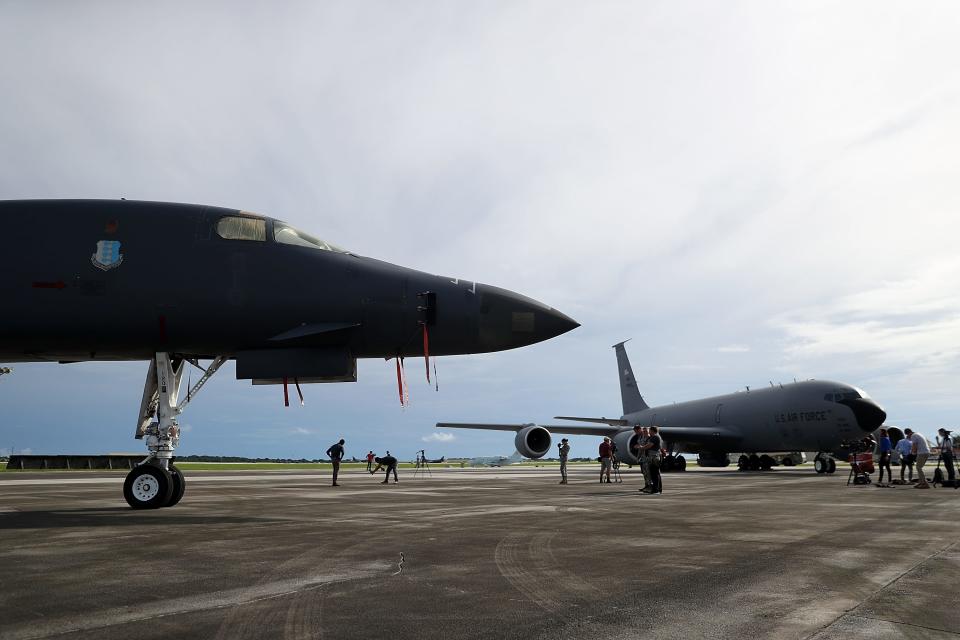US Pacific bases and aircraft are wildly vulnerable to Chinese missile barrages that could overwhelm defenses, lawmakers warn
US bases and aircraft are extremely vulnerable to Chinese missiles, American lawmakers warned in a new letter.
US Pacific bases lack sufficient passive defenses, including hardened aircraft shelters, to survive missile barrages.
In a letter to the Navy and Air Force secretaries, officials demanded "immediate changes."
US bases and aircraft in the Pacific are facing intense threat from Chinese missiles, and the Pentagon isn't doing enough to counter that challenge, according to American lawmakers.
In a Wednesday letter to Air Force Secretary Frank Kendall and Navy Secretary Carlos Del Toro, 13 members of Congress pointed out glaring vulnerabilities in the Pacific region and demanded "immediate changes."
"We are concerned about the alarming lack of urgency by the Department of Defense in adopting such defensive measures," these lawmakers, including the Chairman of the Select Committee on the Chinese Communist Party Rep. John Moolenaar, wrote, referring to the need for more passive defenses, such as hardened aircraft shelters and the dispersal of forces.
The letter paints a dire picture: China has a formidable, threatening missile force with surging numbers of ballistic missiles and launchers, significant reach, and an ability to potentially overwhelm US defenses in the Pacific.
"With its current strike capabilities," the lawmakers wrote, "China can attack all US bases in the region, targeting US service members from Okinawa to those on US territories of Guam and the Commonwealth of the Northern Mariana Islands."
And the consequences of that are severe in a potential conflict, immobilizing air assets and impeding the ability of American forces and its allies to respond to a major war in the Pacific.

In the letter, lawmakers note that many of the US bases in the Pacific remain unhardened, leaving aircraft and assets vulnerable to missile strikes.
Military aircraft are exposed on airfields and in easily detectable and identifiable hangers, and while active defenses such as air- and missile-defense systems are deployable, the sheer amount of Chinese missiles capable of being fired means that bases also need to have passive defenses and sufficient capabilities to get the US back into the fight in the aftermath of a strike. These could be solutions ranging from hardened shelters and underground bunkers to rapid runway repair capabilities.
The lawmakers also wrote that "it is apparent that the Pentagon is not urgently pursuing needed passive defenses," referencing ongoing research by Tom Shugart, a former US Navy officer who is now an adjunct senior fellow at the Center for a New American Security think tank, and Timothy A. Walton, a senior fellow at the Hudson Institute.
The letter shared preliminary information from Shugart and Walton showed a "staggering" difference between the number of Chinese and US hardened aircraft shelters in the Pacific, noting China had built more than 400 compared to just 22 by the US. Notably, none of the US shelters were in Guam — home to Andersen Air Force Base which routinely hosts American bombers.
While none of these efforts would provide complete protection from China's missiles, they would be an upgrade, increasing survivability and thus forcing China to scale up its barrages.
China would have to invest more into a strike to achieve a similar outcome, perhaps demanding more from the People's Liberation Army Rocket Force than it is prepared to give.
Lawmakers noted that no base hardening projects in the Pacific were part of the fiscal year 2024 budget and also highlighted the unfunded projects in the region that "reflect a profound lack of seriousness in strengthening the US bases closest to China and thus most vulnerable to Chinese strikes."

The grave assessment comes as the US looks toward China as its "pacing challenge" and more defense officials and experts acknowledge a clear lack of readiness for potential conflict with Chinese forces.
Last fall, the Pentagon's report on China's military documented a significant build-up across its branches, particularly in its Rocket Force. All of China's missiles able to target US forces across the Pacific region increased in number from 2021 to 2022, with some stockpiles even doubling.
While the US is adapting to the threat as it prepares for potential great-power conflict with China, former and current military leaders as well as experts and analysts have told Business Insider there's more work to be done, especially when it comes to defending against China's missiles.
Read the original article on Business Insider

